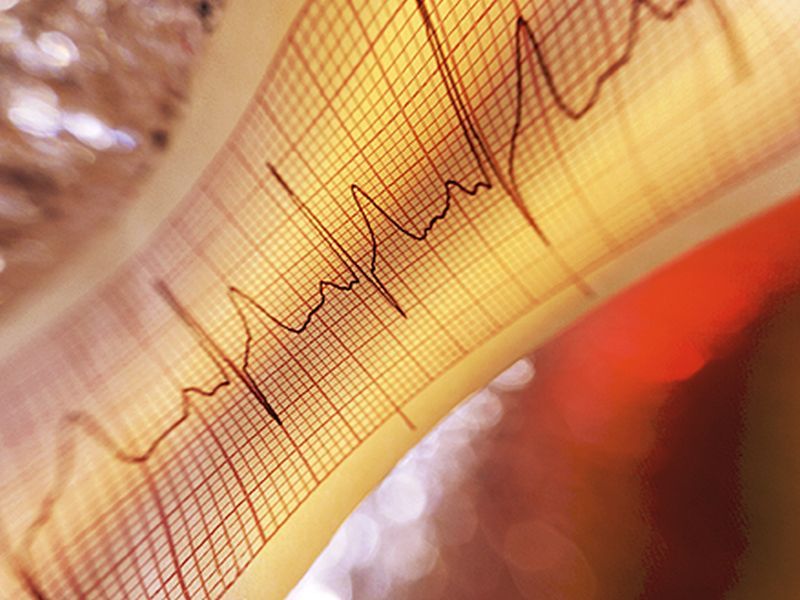FRIDAY, March 12, 2021 (HealthDay News) — One in four U.S. households use smart speakers to check the weather, play music and query search engines. But a new technology may soon have folks asking, “Hey Google, how’s my heart?”
Researchers from the University of Washington, Seattle, have developed a skill for Amazon Alexa and Google Home that allows the devices to check heart rhythms.
Like a bat using echolocation to hunt for food, inaudible sound waves radiate from the speaker and bounce off the surroundings before returning to the device to paint a detailed picture of the space — so detailed, in fact, that the technology can differentiate between a person breathing and her heart beating. This phenomenon is possible because your heart actually creates a tiny movement in your chest wall every time it beats.
“The question we were asking is, ‘Can we transform these smart speakers into ways in which we can do medical diagnosis?'” said researcher Dr. Shyam Gollakota. He’s an associate professor in the University of Washington’s School of Computer Science & Engineering. “Specifically, in the study, we showed that we can use a smart speaker like an Alexa or Google Home to figure out if you have irregular heart rhythm.”
For the technology to work, users must be one to two feet away from the speaker, the researchers said. They tested the accuracy of their work using 26 healthy participants and 24 hospitalized patients with heart conditions, such as atrial fibrillation and heart failure. Then, the scientists collected all participants’ heart rhythms using their sound technology as well as a standard heartbeat monitor.
“This is similar to how Alexa can always find my voice even if I’m playing a video or if there are multiple people talking in the room,” Gollakota explained in a statement. “When I say, ‘Hey, Alexa,’ the microphones are working together to find me in the room and listen to what I say next. That’s basically what’s happening here, but with the heartbeat.”
Of the 12,300 or so heartbeats the researchers collected from the healthy individuals, the smart speaker’s reported time between waves was within 28 milliseconds of the standard heart monitor. For the nearly 5,600 heartbeats collected from people with cardiac conditions, the speaker’s time differed from the monitor by 30 milliseconds.
The findings were published online March 9 in the journal Communications Biology.
“I think the exciting part of the study is that we actually evaluated this with patients with cardiac conditions like heart transplants, irregular heartbeats and a variety of different heart conditions,” Gollakota said. “And it was really promising that even not just for regular participants, but even people who are actually in the hospital with cardiac conditions, it was able to deliver the results. So, that’s actually pretty promising.”
The ultimate goal of the technology is to allow people to monitor their heart from the comfort of their homes, the study authors said.
Heart checks from the comfort of your home
“One of the things with cardiac conditions like, for example, irregular heart rhythms is that they don’t appear often,” Gollakota explained. “So, having a solution which is nonintrusive, contactless and it’s just sitting by your desk and monitoring your heartbeat all the time, can be pretty promising,” he said.
“The second advantage is that as we have seen with COVID, a lot of the [medical] practice has actually gone online to telemedicine,” Gollakota added. “So, in this telemedicine set-up, if you want to monitor someone’s heart conditions, or figure out if they have irregular heartbeats, a tool like this can be pretty useful to perform tests and understand how the heartbeat of the person is.”
Dr. Regina Druz, chair of the American College of Cardiology’s Health Care Innovation Section and Leadership Council, said the technology is innovative and likely the future of telemedicine. She could see it being effective in community homes or for chronic patients to monitor signs of clinical deterioration.
However, there could be some potential drawbacks to the concept.
“With the sicker patient populations, the technology may not show a good degree of correlation with established and well-known and widely prevalent diagnostic tools,” Druz explained. “Patient populations are more diverse [than just having a single issue]. They have congestive heart failure; they have various abnormalities of heart function, both structural, functional and rhythm abnormalities that potentially could compromise how accurate this technology is.”
This latest smart speaker adaptation is just one example of how existing technology is being rejiggered to try to improve the health of users. According to a survey conducted last year by the Pew Research Center, about one in five Americans have smart watches, and the medical capabilities of these devices are rapidly expanding. Fitbit CEO James Park, for example, told Axios in February that his company’s product can now help detect a coronavirus infection and depression in the early stages.
While these tools can be lifesaving in some cases, they can also cause unnecessary worry. For example, a study published last fall in the Journal of the American Medical Informatics Association found that only around 10% of people who went to the doctor after receiving an abnormal pulse reading from the Apple Watch were later diagnosed with a cardiac condition.
But if technology like smart watches and smart speakers become accurate enough, they could improve health care inequities by allowing those who are uninsured or underinsured or who live far away from physicians to monitor their health without scheduling a doctor’s visit.
More information
Visit the University of California, Los Angeles, for more on smart technology and health.
SOURCES: Shyam Gollakota, associate professor, Paul G. Allen School of Computer Science & Engineering, University of Washington, Seattle; Regina Druz, MD, chair, American College of Cardiology’s Health Care Innovation Section and Leadership Council; Communications Biology, March 9, 2021, online
Copyright © 2025 HealthDay. All rights reserved.

